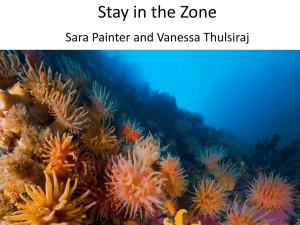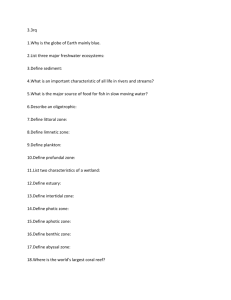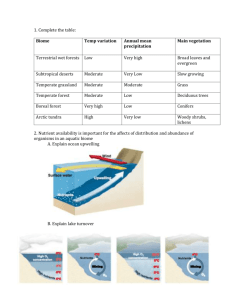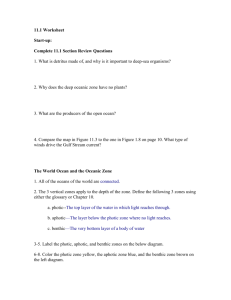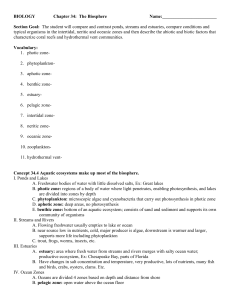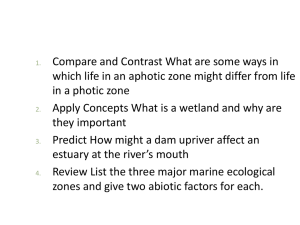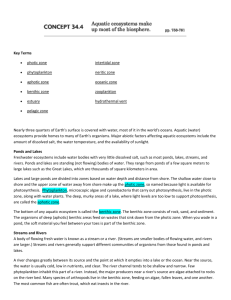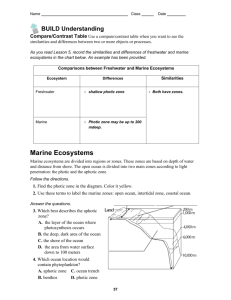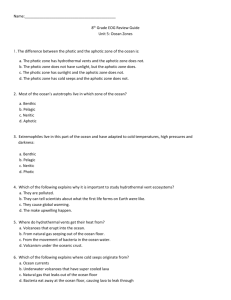Aquatic Ecosystems make up most of the Biosphere
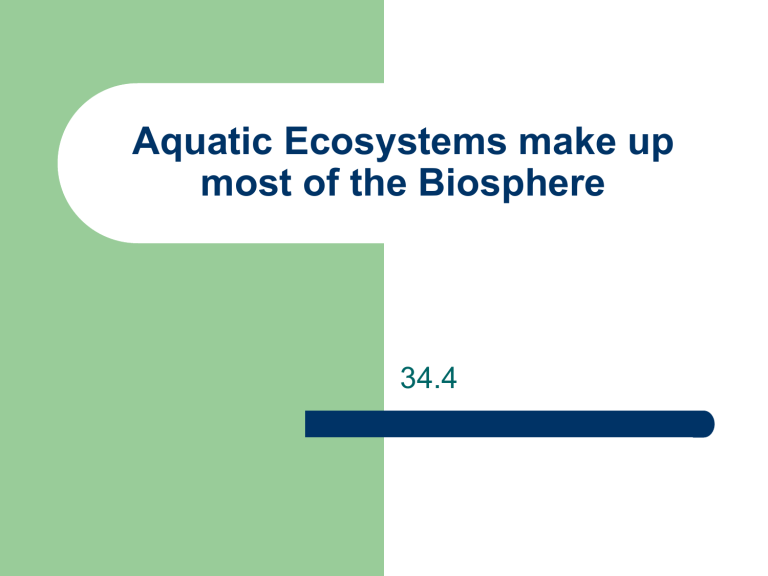
Aquatic Ecosystems make up most of the Biosphere
34.4
Ponds and Lakes
Freshwater ecosystems include water bodies with very little dissolved salt, such as most ponds, lakes, streams, and rivers.
Ponds and lakes are standing (not flowing) bodies of water.
Lakes and large ponds are divided into zones based on water depth and distance from shore.
The shallow water close to shore and the upper zone of water away from shore make up the photic zone, so named because light is available for photosynthesis.
Phytoplankton, microscopic algae and cyanobacteria that carry out photosynthesis, live in the photic zone, along with water plants.
The deep, murky areas of a lake, where light levels are too low to support photosynthesis, are called the aphotic zone.
The bottom of any aquatic ecosystem is called the benthic zone.
The benthic zone consists of rock, sand, and sediment.
The organisms of deep (aphotic) benthic areas feed on wastes that sink down from the photic zone.
Streams and Rivers
A body of flowing fresh water is known as a stream or a river.
A river changes greatly between its source and the point at which it empties into a lake or the ocean.
Near the source, the water is usually cold, low in nutrients, and clear.
Few phytoplankton inhabit this part of a river.
Instead, the major producers near a river's source are algae attached to rocks on the river bed.
Many species of arthropods live in the benthic zone, feeding on algae, fallen leaves, and one another.
Downstream from its source, a river generally becomes wider and deeper.
Marshes and other wetlands are common in these downstream areas.
The water is usually warmer and murkier than it is upstream.
More phytoplankton live in this part of a river.
Estuaries
Streams and rivers merge with ocean water in areas known as estuaries.
Estuary organisms experience changes in salt concentration and temperature as the fresh water and salt water mix.
Estuaries serve as breeding grounds for many invertebrate and fish species, and as nesting and feeding areas for a great diversity of birds.
Along most of the east coast of the United
States, the major ecosystems found in estuaries are salt marshes.
In tropical areas, the typical estuary ecosystems are mangrove swamps.
These swamps are dominated by mangrove trees, which are anchored by tangled networks of arching roots.
Ocean Zones
Zones of depth include the benthic zone, or ocean floor, and the pelagic zone, or open water above the ocean floor.
Also as in freshwater ecosystems, the ocean has a photic zone, which receives enough sunlight to support photosynthesis, and a dark aphotic zone.
Zones of distance from shore include the intertidal zone, neritic zone, and oceanic zone.
Intertidal Zone
The area of shore between the high-tide and low-tide lines is called the intertidal zone.
Pounded by waves during high tide and exposed to the sun and drying winds during low tide, benthic organisms in this zone must be well-adapted to survive these harsh conditions
Neritic Zone
The area of the ocean from the low-tide line out to the edge of the continental shelf is the neritic zone.
Since the ocean here is fairly shallow, some sunlight reaches the bottom in most of the neritic zone.
As a result, many organisms that require light for photosynthesis can live in this zone, including seaweeds and phytoplankton.
Oceanic Zone
The vast open ocean from the edge of the continental shelf outward is called the oceanic zone.
Phytoplankton drifting in the photic layer are the major producers in this zone.
Microscopic animals called zooplankton also inhabit the photic zone and in turn are a source of food for other animals.
Coral Reefs
All the invertebrate phyla are found on coral reefs, including sponges, sea anemones, worms, sea stars, and mollusks.
Vertebrates such as sea turtles and fishes also roam the reefs.
Most reefs are formed by colonies of coral polyps, animals in the phylum Cnidaria that secrete hard external skeletons.
Deep-sea Vents
Imagine the surprise of biologists when they first glimpsed giant tube worms living at depths of 2,500 meters.
These unfamiliar organisms live around deep-sea hydrothermal vents, spots on the ocean floor where hot gases and minerals escape from Earth's interior into the water.
No sunlight reaches this deep, dark zone.
The vent communities use the chemical energy from Earth's interior as their energy source.
The producers in these ecosystems are prokaryotes that, instead of carrying out photosynthesis, can extract energy from sulfur compounds spewing from the vents and use this energy to make carbohydrates.
